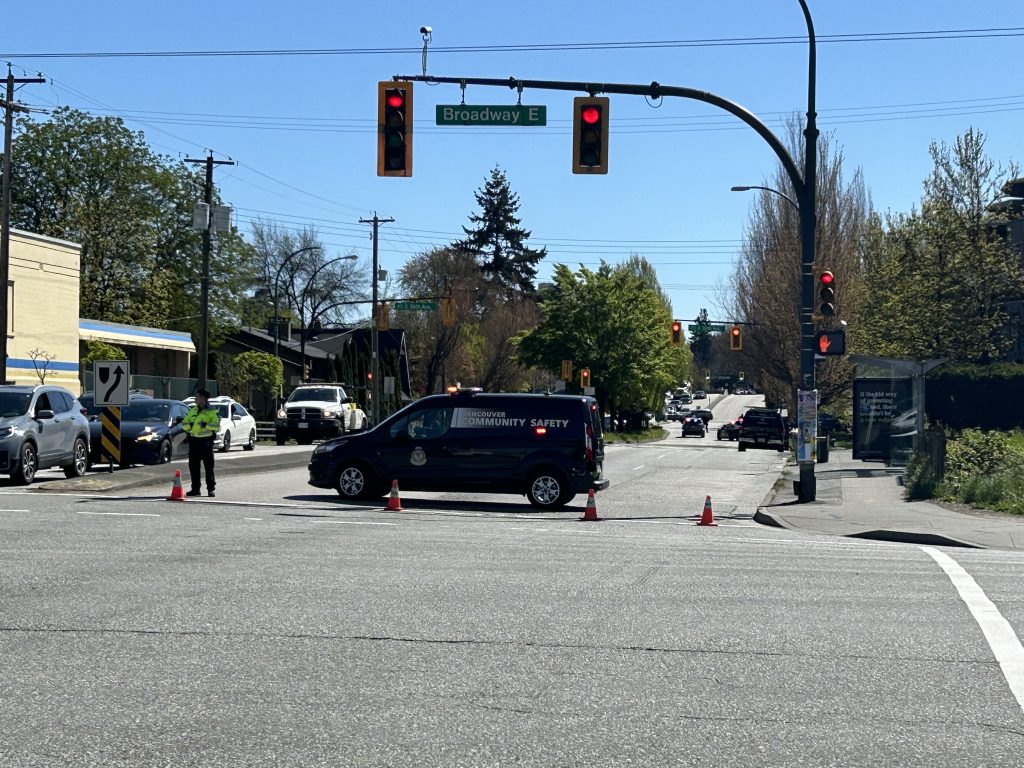University of Texas museum unveils painting of Klan members
Posted July 19, 2018 6:11 am.
Last Updated July 19, 2018 3:20 pm.
This article is more than 5 years old.
AUSTIN, Texas – While he was working at a San Antonio movie theatre as a youth, Vincent Valdez stepped outside into the abrupt chaos of protesters and counterprotesters in Alamo Plaza.
The Austin American-Statesman reports that was when he came face to face with a grand dragon of the Ku Klux Klan, hooded but unmasked.
“We stared at each other for what seemed like minutes,” artist Valdez told Maria Hinojosa, host of National Public Radio’s “Latino USA,” along with a full auditorium of rapt listeners, at the University of Texas on Tuesday. “It was probably only a few seconds.”
UT’s Blanton Museum of Art knew it had a potential artistic bombshell in hand long before Tuesday, when it unveiled Valdez’s alarming 30-foot, four-panel painting “The City I,” a monochromatic treatment of modern-day Klan members pictured on the ragged edge of a city. So museum leaders say they spent the better part of the past year generating a quiet dialogue on depictions and interpretations of race and racism.
The panoramic “The City I” and the smaller but closely related painting “The City II,” known together as “The City,” were acquired by the university’s museum after director Simone Wicha spent years studying and admiring the San Antonio-born, Houston-based artist’s hyper-realistic canvases.
The museum had already received, as a promised gift from top collectors Jeanne and Mickey Klein, part of Valdez’s series “The Strangest Fruit,” which shows Hispanic men lynched — without visible nooses — by white supremacists. Two red-tinted canvases from that series are on view in a room next to the Contemporary Project gallery, where the Klan painting can be seen for the next eight months.
Tuesday’s somewhat tense opening was set against the backdrop of recent race-informed protests elsewhere against a painting of Emmett Till’s mutilated body by a white artist, displayed at the Whitney Museum of American Art, distorted images of African-Americans in St. Louis, and a gallows structure taken down at the Walker Art Center in Minneapolis after Native Americans said it recalled the hanging of Dakota Indians.
During the program Tuesday, Valdez emphasized the usually muted ubiquity of white supremacy in modern American life. He also said that some of the images in “The City” anticipated rather than followed current events. One key detail, for instance, is a smouldering torch whose smoke encircles the Klan figures.
“That came to me before Charlottesville,” Valdez said in answer to one of Hinojosa’s questions. “It seemed to me they were coming to life.”
Valdez portrays the hooded group, including an infant, not acting in rage or violence but looking directly at the viewer as an otherwise ordinary family unit gathered under a cell tower illuminated by headlights and dim moonlight. The scene is marked by mundane details such as a glowing cellphone, a Chevy truck, Budweiser beer cans, an American flag patch and manicured fingers.
Concerned with possible reactions or interpretations, Wicha delayed its planned exhibition and convened small groups from inside and outside UT to discuss its potential impact.
“It was going to be installed earlier, but I shifted it back one year,” Wicha said Tuesday. “I felt it was really important to engage the community in thoughtful, prepared dialogue beforehand. I am grateful to and proud of the people involved.”
She contradicted previous media reports that the delay was connected to the election of President Donald Trump, saying that she was misunderstood.
One particular roundtable gathering of two dozen faculty members, including those from the fields of history, art history, social work, African-American studies and Latino studies, held three long meetings, the first in 2017.
“It was an extraordinary group,” Wicha said. “We talked about how the work could be integrated into their own teaching, and we held conversations about possible interpretations of the work. We put the painting up in the gallery when the museum was closed, and they sat in groups in front of it. Many of those who commented asked to be part of our upcoming symposium.”
That primary symposium, “Facing Racism: Art & Action,” will be led Sept. 27 by Kellie Jones, professor of art history and archaeology at Columbia University and associated with its Institute for Research in African-American Studies. The museum also will stage community conversations every other week between now and Oct. 27 — and beyond that if public interest persists.
During the past year, the museum worked with the Anti-Defamation League and the Austin school district to devise lesson plans to accompany Valdez’s unsettling artwork.
Although the museum staff contacted Austin social justice groups during the past year, the New York Times reported this week that Nelson Linder, head of the local chapter of the NAACP, did not learn about the showing until early July. That caused some concern, since his organization was founded primarily to confront a scourge of lynchings of African-Americans in the early 20th century.
Linder, who took a break from the NAACP national convention in San Antonio on Tuesday to attend the Blanton program, said it was clearly an oversight and emphasized other educational opportunities, such as visiting the memorial marker outside Wesley United Methodist Church in East Austin that details a lynching in Travis County.
At Tuesday’s program, Valdez, whose influences include Old Masters such as Caravaggio and Goya but also American muralist Thomas Hart Benton, Houston artist John Biggers and painter of Klan subjects Philip Guston, repeated how timely and proximate the themes remained in a time of mass incarceration, intrusive and deadly policing, zero tolerance immigration policies and unequal schooling. While these specific themes are not self-evident in his paintings, they clearly inform Valdez’s point of view.
The Austin showing comes with a posted warning that it “may elicit strong emotions,” similar to alerts given for previous Blanton shows that contained intimations of violence or other potentially disturbing subjects.
What might disturb viewers more than anything is the mundane feeling of the piece: It could be happening anywhere at any time in America.
“What troubled me most was that they were ordinary citizens, no greater or less than I,” Valdez said. “Once you see, you can never learn to unsee.”
Wicha said that while the more compact “The City II,” which shows a pile of mattresses, boxes and bins along with a smashed TV set and a fire smouldering in a barrel against the same distant city lights as in “City I,” can be shown with the regular collection, the epic, almost cinematic “The City I” will go into storage after eight months but will be made available for museum loans and special educational showings.
___
Information from: Austin American-Statesman, http://www.statesman.com
This is an AP Member Exchange shared by the Austin American-Statesman










